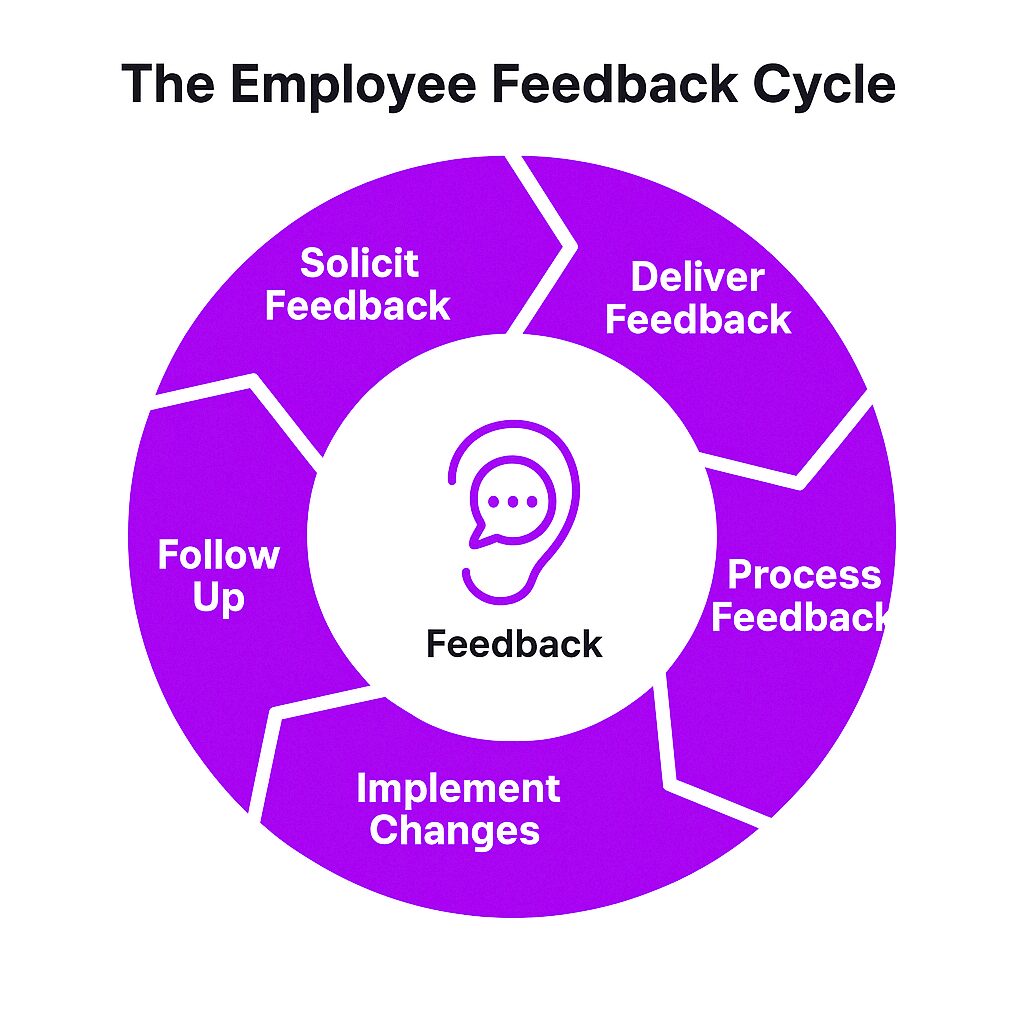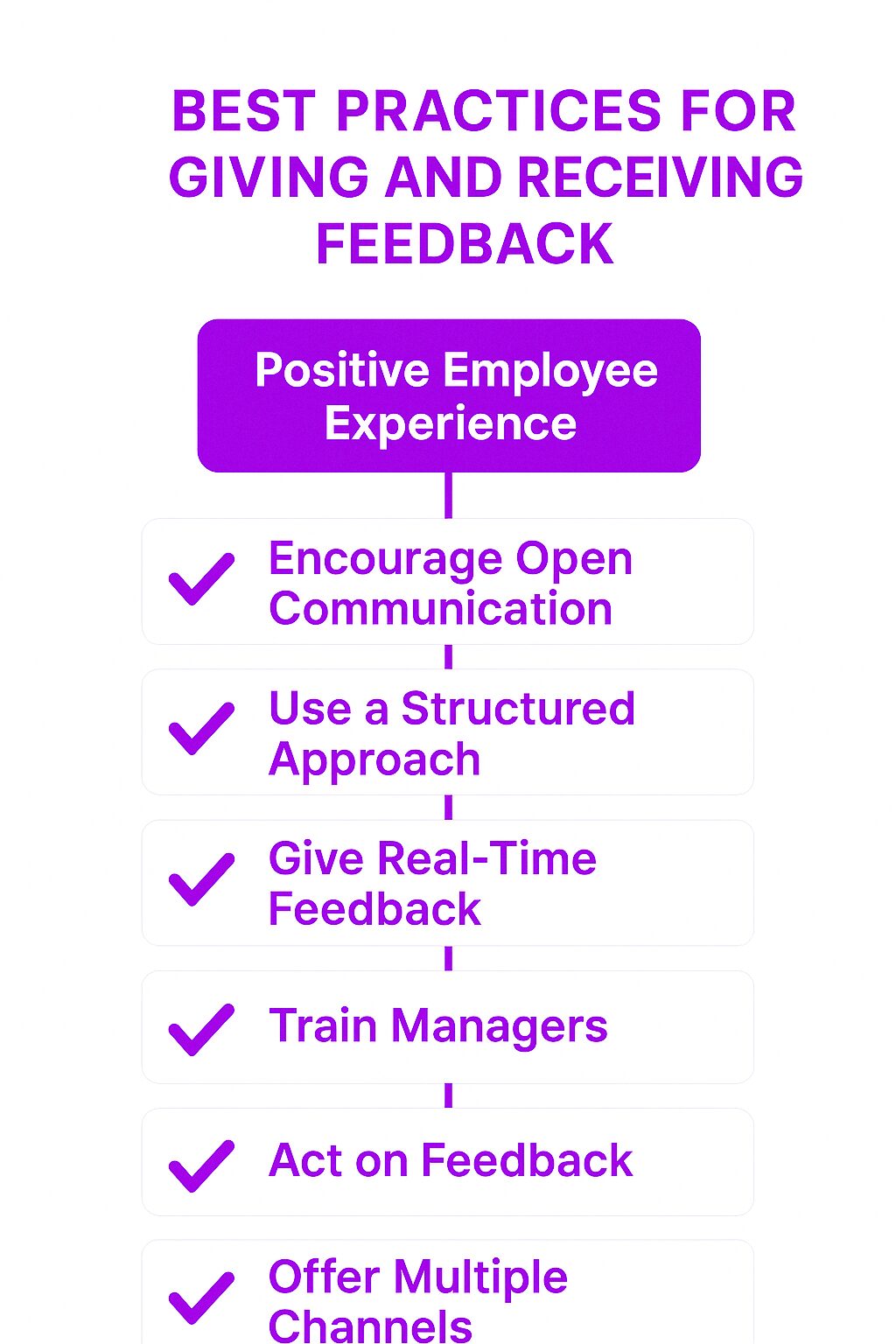What is Employee Feedback?
Employee feedback refers to the process of exchanging information between employees and employers about workplace performance, job satisfaction, and overall experience. It is an essential part of maintaining a productive and engaged workforce. Feedback can be formal or informal, given in one-on-one meetings, team discussions, or structured surveys. Formal employee feedback is a structured and documented method of providing input on performance, particularly through channels like performance reviews and evaluations.
Unlike traditional performance reviews, employee feedback is not limited to annual evaluations. It is an ongoing process that helps organizations identify challenges, recognize achievements, and foster a culture of continuous improvement. When done correctly, it creates a transparent work environment where employees feel heard and valued.
Why Employee Feedback Matters
Feedback is a two-way street. Employees want to know how they are performing, and employers need insights into how workplace policies and culture affect job satisfaction. A strong feedback culture improves communication, boosts morale, and helps businesses retain top talent.
When employees receive clear and constructive feedback, they understand what is expected of them. They also feel more engaged in their roles. On the other hand, when organizations actively seek employee input, they can identify pain points and make meaningful improvements that benefit both employees and business performance. Meaningful feedback is crucial for fostering trust, collaboration, and team dynamics in the workplace.
Key Stages of Employee Feedback
Soliciting Feedback
Before feedback can be used effectively, organizations need to create opportunities for employees to share their thoughts. This can be done through surveys, one-on-one meetings, team discussions, or anonymous suggestion boxes. The key is to create a culture where employees feel safe expressing their opinions without fear of retaliation.
Delivering Feedback
Feedback should be clear, specific, and constructive. Constructive employee feedback is a vital tool for redirecting employees toward more successful behaviors and actions, offering specific, actionable suggestions while maintaining an encouraging tone. When providing feedback, managers should focus on behaviors rather than personal traits. Using a structured approach, such as the “SBI” method (Situation, Behavior, Impact), helps employees understand the feedback and apply it to their work.
Processing Feedback
Collecting feedback is only useful if organizations act on it. Employers need to analyze trends and identify recurring issues. If multiple employees raise similar concerns, leadership must investigate and address the root causes.
Implementing Changes
Once feedback has been processed, organizations should make meaningful changes based on employee input. Regular insights into employee’s performance can drive personal growth and organizational success. Whether it’s adjusting workplace policies, improving communication channels, or enhancing professional development programs, acting on feedback demonstrates that employee opinions matter.
Following Up
Feedback should be an ongoing process. Organizations should check in regularly to see if changes have been effective and continue gathering input. This reinforces a culture of transparency and continuous improvement.
Purpose and Importance of Employee Feedback for Employee Engagement
Employee feedback plays a crucial role in workplace development. It helps organizations:
-
Identify strengths and weaknesses.
-
Improve employee engagement and satisfaction.
-
Reduce turnover by addressing concerns before they escalate.
-
Foster better communication between employees and management.
-
Encourage professional growth and skill development.
-
Strengthen company culture by promoting transparency and trust.
When feedback is handled properly, it leads to a more engaged workforce, stronger leadership, and a more resilient organization.
Types of Employee Feedback
Employee feedback is a crucial aspect of any organization, and it comes in various forms. Understanding the different types of employee feedback is essential for managers and leaders to provide effective feedback that promotes growth, engagement, and performance.
Positive Employee Feedback
Positive employee feedback is a type of feedback that recognizes and appreciates employees’ achievements, strengths, and contributions. It is essential for building trust, boosting morale, and encouraging employees to continue performing well. Positive feedback can be given in various forms, such as recognition, rewards, or simply acknowledging an employee’s hard work and dedication.
Positive employee feedback examples include:
-
Recognizing an employee’s outstanding performance in a team meeting.
-
Providing a bonus or reward for achieving a specific goal.
-
Writing a positive review or recommendation on an employee’s performance.
-
Offering a promotion or new opportunities for growth and development.
By regularly offering positive feedback, managers can foster a positive attitude and a motivated workforce, ultimately enhancing overall employee performance.
Constructive Feedback
Constructive feedback is a type of feedback that provides employees with specific, actionable suggestions for improvement. It is essential for helping employees develop new skills, address performance issues, and grow professionally. Constructive feedback should be given in a supportive and respectful manner, focusing on the behavior or action rather than the person.
Constructive feedback examples include:
-
Providing specific examples of areas for improvement.
-
Offering suggestions for training or development opportunities.
-
Setting clear goals and expectations for future performance.
-
Encouraging employees to reflect on their own performance and identify areas for improvement.
When delivered effectively, constructive feedback can transform challenges into opportunities for growth, helping employees enhance their skills and contribute more effectively to the organization.
Upward Feedback
Upward feedback is a type of feedback that is given from employees to their managers or supervisors. It is essential for helping managers understand their strengths and weaknesses, identify areas for improvement, and develop their leadership skills. Upward feedback can be given in various forms, such as regular check-ins, anonymous surveys, or performance reviews.
Upward feedback examples include:
-
Providing feedback on a manager’s communication style or leadership approach.
-
Suggesting new ideas or initiatives for the team or organization.
-
Offering constructive criticism on a manager’s decision-making or problem-solving skills.
-
Recognizing a manager’s strengths and accomplishments.
By encouraging upward feedback, organizations can create a more open and collaborative environment where managers and employees work together to achieve common goals.
Benefits and Challenges of Employee Feedback
Benefits
-
Boosts Employee Morale: Employees who receive recognition and constructive feedback feel valued and motivated.
-
Improves Collaboration: Open communication strengthens teamwork and cooperation.
-
Enhances Retention Rates: Addressing employee concerns proactively reduces turnover.
-
Encourages Innovation: Employees who feel heard are more likely to contribute new ideas.
-
Identifies Areas for Growth: Helps employees and managers understand where improvements are needed.
Challenges
-
Fear of Repercussions: Employees may hesitate to give honest feedback if they fear negative consequences.
-
Poorly Delivered Feedback: If feedback is vague or overly critical, it can lead to confusion and resentment. Negative employee feedback must be delivered constructively and objectively to promote self-correction instead of demoralization or disengagement.
-
Lack of Follow-Through: Employees become disengaged if they feel their feedback is ignored.
-
Difficulty in Measuring Feedback Impact: Organizations struggle to track progress if there are no clear metrics.
Sharing Negative Feedback
Sharing negative feedback can be challenging, but it is essential for helping employees grow and develop. Negative feedback should be given in a constructive and respectful manner, focusing on the behavior or action rather than the person.
When sharing negative feedback, it is important to:
-
Be specific about the issue and provide clear examples.
-
Focus on the behavior or action, not the individual.
-
Offer actionable suggestions for improvement.
-
Ensure the feedback is timely and relevant.
-
Maintain a supportive and respectful tone.
By approaching negative feedback with care and consideration, managers can help employees address performance issues and develop their skills, ultimately contributing to a more effective and engaged workforce.
Practical Tips and Best Practices for Employee Feedback
Encourage Open Communication
Employees should feel comfortable sharing their thoughts. Managers should create an environment where feedback is welcomed and valued.
Use a Structured Approach
Using frameworks like the “SBI” method (Situation, Behavior, Impact) or “Stop, Start, Continue” (what to stop doing, what to start doing, what to continue) makes feedback more actionable.
Provide Real-Time Positive Feedback
Feedback should not be reserved for annual reviews. Providing feedback in real time helps employees make immediate improvements and stay engaged.
Train Managers on Giving Constructive Criticism
Not all managers are skilled in delivering feedback. Organizations should provide training on how to give constructive and effective feedback. Manager feedback is crucial for improving leadership qualities, and employees should feel empowered to provide feedback to their superiors.
Act on Feedback
Collecting feedback is meaningless if organizations do not act on it. Employers should communicate what actions they are taking in response to feedback.
Offer Multiple Feedback Channels
Not all employees are comfortable speaking up in meetings. Offering anonymous surveys, one-on-one discussions, and digital platforms for feedback gives employees different ways to express their thoughts.
Related Sub-Concepts
360-Degree Feedback
This approach gathers feedback from multiple sources, including peers, managers, and direct reports, to provide a well-rounded evaluation of an employee’s performance.
Real-Time Feedback
Instead of waiting for scheduled reviews, real-time feedback allows managers and employees to address issues or recognize achievements as they happen.
Anonymous Feedback
Anonymity encourages employees to be honest about their concerns without fear of repercussions.
Managerial Feedback vs. Peer Feedback
Managerial Feedback: Given by supervisors to employees to guide performance and growth. Positive and negative feedback are both essential for reinforcing good behavior and driving improvement when delivered constructively.
Peer Feedback: Given by colleagues to foster teamwork and collaboration.
Real-World Feedback Examples of Employee Feedback in Action
Google uses a feedback-rich culture to drive innovation. Employees are encouraged to provide feedback through regular surveys, open forums, and direct communication with leadership. Constructive employee feedback examples highlight specific scenarios in which feedback is provided to employees in a way that promotes growth and improvement. The company actively responds to feedback, implementing changes that improve work-life balance and professional development.
Microsoft
Microsoft has implemented a continuous feedback model, replacing traditional annual reviews with regular check-ins between managers and employees. This approach has improved engagement and productivity.
Facebook (Meta)
Facebook uses peer feedback to build a culture of transparency. Employees can give real-time feedback through internal tools, fostering collaboration and accountability.
Datto
Datto increased employee engagement by implementing feedback-driven changes. After noticing low adoption rates of their intranet, they gathered employee input and revamped their communication tools, leading to full engagement across the organization. Negative employee feedback examples can guide managers on how to approach these conversations effectively.
The Future of Employee Feedback
Employee feedback will continue to evolve as organizations adopt new technologies. AI-driven sentiment analysis, real-time feedback tools, and digital engagement platforms will play a larger role in gathering and analyzing employee input.
Organizations that prioritize feedback as an ongoing process rather than a one-time event will be better positioned to adapt, grow, and retain top talent. By fostering a culture of openness, acting on insights, and continuously refining feedback processes, companies can create an environment where employees feel valued, heard, and empowered to succeed.








